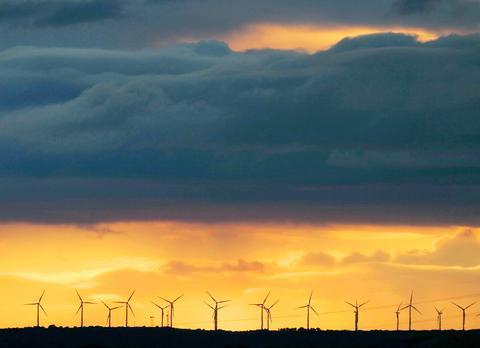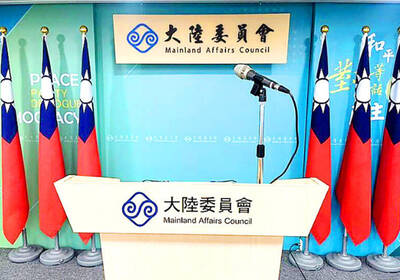Germany is the world's undisputed world leader in producing electricity from wind power after more than a decade of rapid expansion, but the country does lag behind in the final frontier of wind energy -- offshore windparks.
But now Germany's wind power industry is forging ahead with work starting on some of the first windparks in the North Sea and Baltic Sea in a development which many people hope will work out for a reason completely unrelated to a clean environment.
The derogatory term Verspargelung is making the rounds in Germany, a word which roughly means "turning into asparagus fields" -- an apt description of how the towering wind generators and their rotor blades resemble giant asparagus plants cluttering the horizon.

PHOTO: REUTERS
With more than 15,000 wind generators around the country, Germany produces as much electricity from wind as Denmark, Spain and the US all combined. By the year 2010, wind-generated electrical production is to be doubled once again.
But space is running out on land, and with opposition to windparks rising from various quarters, including the tourism sector worried about Germany's scenic landscapes, the industry is now heading offshore.
The federal maritime shipping and hydrography office (BSH) in Hamburg is now reviewing 30 applications for offshore parks, and four have been approved. The first offshore parks will be starting up in 2006 at the earliest -- years behind such facilities in Denmark, Sweden and England.
"We have made things more difficult for ourselves than others," commented Fritz Vahrenholt, chairman of the REpower wind engineering firm in Hamburg, referring to drawn-out debates and delays due to environmental impact considerations.
"It is really astonishing how a technology-oriented country like Germany always reacts with fear and loathing to everything that is new," added Sven Teske of the environmental group Greenpeace.
Besides economic feasibility considerations, nature preservation has dominated the debate over proposed offshore windparks. Amid many restrictions, it will mean that Germany's offshore parks will have to be positioned as far as 40km out at sea, with the windmills' concrete foundations having to be built at depths of 30m.
Greenpeace's Teske notes that at the moment, "there is no windpark anywhere in the world which is more than 15km offshore".
Vahrenholt, commenting on the concerns expressed that Germany's sea horizons could become cluttered with windmills and on the impact of offshore parks on the marine environment, noted:
"The density of the animal population is lower and the towers can't be seen from land [at that distance]."
As German firms prepare for the country's first offshore parks, some are reporting some major new developments. At Cuxhaven, the REPower company is now working on a prototype of a 5-megawatt generator -- about double the size of today's largest wind generators.
Soon to be tested on land, ultimately the 5-MW wind generator is meant for offshore. Its dimensions -- a tower 183m high and the rotor blade circumference of 125m, or more than the length of a football field, can only be feasibly put to use far out at sea.
Offshore windparks, particularly the further out they are and the deeper the water they have to be built in, pose much greater technical and engineering challenges than land-based windmills do, adding substantially to the costs.
A company in Rostock, Arcadis, hopes to substantially cut the costs with its "floating windmill."
The idea is first to build the wind tower, complete with its concrete foundation, in a harbor, and then to tow it offshore for final installation on the seabed. Such a facility can also be towed back to shore for repair and maintenance work, thereby reducing the technical challenge of performing such work out at sea.
Arcadis has won approval for a first prototype 2-MW floating windmill at the "Ventotec Ost 2" offshore windpark planned some 35km northeast of the Baltic Sea island of Ruegen. Ultimately, the offshore park is to have installed capacity of 600MW.
Under German government plans, by the year 2020, some 20,000 megawatts of electricity are to be derived from offshore windparks.

‘DANGEROUS GAME’: Legislative Yuan budget cuts have already become a point of discussion for Democrats and Republicans in Washington, Elbridge Colby said Taiwan’s fall to China “would be a disaster for American interests” and Taipei must raise defense spending to deter Beijing, US President Donald Trump’s pick to lead Pentagon policy, Elbridge Colby, said on Tuesday during his US Senate confirmation hearing. The nominee for US undersecretary of defense for policy told the Armed Services Committee that Washington needs to motivate Taiwan to avoid a conflict with China and that he is “profoundly disturbed” about its perceived reluctance to raise defense spending closer to 10 percent of GDP. Colby, a China hawk who also served in the Pentagon in Trump’s first team,

SEPARATE: The MAC rebutted Beijing’s claim that Taiwan is China’s province, asserting that UN Resolution 2758 neither mentions Taiwan nor grants the PRC authority over it The “status quo” of democratic Taiwan and autocratic China not belonging to each other has long been recognized by the international community, the Mainland Affairs Council (MAC) said yesterday in its rebuttal of Beijing’s claim that Taiwan can only be represented in the UN as “Taiwan, Province of China.” Chinese Minister of Foreign Affairs Wang Yi (王毅) yesterday at a news conference of the third session at the 14th National People’s Congress said that Taiwan can only be referred to as “Taiwan, Province of China” at the UN. Taiwan is an inseparable part of Chinese territory, which is not only history but

CROSSED A LINE: While entertainers working in China have made pro-China statements before, this time it seriously affected the nation’s security and interests, a source said The Mainland Affairs Council (MAC) late on Saturday night condemned the comments of Taiwanese entertainers who reposted Chinese statements denigrating Taiwan’s sovereignty. The nation’s cross-strait affairs authority issued the statement after several Taiwanese entertainers, including Patty Hou (侯佩岑), Ouyang Nana (歐陽娜娜) and Michelle Chen (陳妍希), on Friday and Saturday shared on their respective Sina Weibo (微博) accounts a post by state broadcaster China Central Television. The post showed an image of a map of Taiwan along with the five stars of the Chinese flag, and the message: “Taiwan is never a country. It never was and never will be.” The post followed remarks

INVESTMENT WATCH: The US activity would not affect the firm’s investment in Taiwan, where 11 production lines would likely be completed this year, C.C. Wei said Investments by Taiwan Semiconductor Manufacturing Co (TSMC, 台積電) in the US should not be a cause for concern, but rather seen as the moment that the company and Taiwan stepped into the global spotlight, President William Lai (賴清德) told a news conference at the Presidential Office in Taipei yesterday alongside TSMC chairman and chief executive officer C.C. Wei (魏哲家). Wei and US President Donald Trump in Washington on Monday announced plans to invest US$100 billion in the US to build three advanced foundries, two packaging plants, and a research and development center, after Trump threatened to slap tariffs on chips made